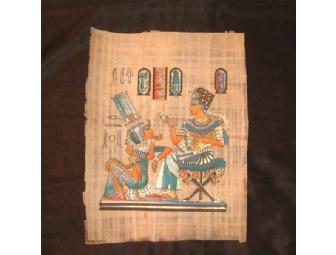UNHCR
PAPYRUS: #118 EGYPTIAN PAPYRUS ART!
- Item Number
- 1541
- Estimated Value
- 150 USD
- Opening Bid
- 50 USD
Item Description
Details of this item
Hand painted on Papyrus
Size: 17" x 14" (approx.)
Country of Origin: Egypt
Material: Papyrus
Status: Unframed
100% net proceeds benefit:
UNHCR
The Office of the United Nations High Commissioner for Refugees UNHCR was established on December 14, 1950 by the United Nations General Assembly. The agency is mandated to lead and co-ordinate international action to protect refugees and resolve refugee problems worldwide. Its primary purpose is to safeguard the rights and well-being of refugees. It strives to ensure that everyone can exercise the right to seek asylum and find safe refuge in another State, with the option to return home voluntarily, integrate locally or to resettle in a third country. It also has a mandate to help stateless people. In more than six decades, the agency has helped tens of millions of people restart their lives. Today, a staff of some 7,190 people in more than 120 countries continues to help some 36.4 million persons.
UNHCR has received support from many notable celebrities including Angelina Jolie, Brad Pitt and Mick Jagger.
How you can help
It is our goal at the Art4Good Foundation, Inc. to raise$1,000.00 in direct donations and proceeds resulting from ongoing on-line auctions in 2012, that also promote and support The Arts!
 We hope you will share our commitment and enthusiasm and join the team! You can join the team, donate 10 bucks, vote, invite others to jam with us, or simply keep track of our progress!
We hope you will share our commitment and enthusiasm and join the team! You can join the team, donate 10 bucks, vote, invite others to jam with us, or simply keep track of our progress!
Papyrus Art
Papyrus was very important to the ancient Egyptians. It helped transform Egyptian society in many ways. Once the technology of papyrus making was developed, its method of production was kept secret allowing the Egyptians to have a monopoly on it. The first use of papyrus paper is believed to have been 4000 BC.
The raw material of papyrus paper comes from the plant Cyperus papyrus. This plant grew along the banks of the Nile and provided the Egyptians with the necessary raw materials. This plant was quite versatile and was not only used in the production of paper but it was also used in the manufacture of boats, rope and baskets. However, the singularly most important and valuable product was the papyrus paper. Not only was this ancient Egypt‘s greatest export but it revolutionized the way people kept valuable information. No substitution for papyrus paper could be found that was as durable and lightweight until the development of pulped paper by the Arabs. The way of making pulp paper was far easier to produce but not as durable. This not only led to a decline in papyrus paper making, but also to a decline in the papyrus plant cultivation. Eventually, the papyrus plant disappeared from the area of the Nile, where it was once the lifeblood for ancient Egypt.
Papyrus making was not revived until around 1969. An Egyptian scientist named Dr. Hassan Ragab reintroduced the papyrus plant to Egypt and started a papyrus plantation near Cairo. He also had to research the method of production. Because the exact methods for making papyrus paper were such a secret, the ancient Egyptians left no written records as to the manufacturing process. Dr. Ragab finally figured out how it was done, and now papyrus making is back in Egypt after a very long absence.
This Papyrus is planted and made in reputable factory and farm and is an Egyptian craft and has same chemical and physical properties that our ancient Egyptian Papyrus had. It has the same fibers, the dark legenic cells, the horizontal and vertical lines. Its ability to be rolled in addition to long life. You can write on the papyrus, using watercolor, oil color, coal and printer.
NOTE: We advise framing Papyrus works between 2 pieces of plexi-glass or glass.
Item Special Note
SHIPPING AND HANDLING: $39.95
ART+more4Good stores data...
Your support matters, so ART+more4Good would like to use your information to keep in touch about things that may matter to you. If you choose to hear from ART+more4Good, we may contact you in the future about our ongoing efforts.
Your privacy is important to us, so ART+more4Good will keep your personal data secure and ART+more4Good will not use it for marketing communications which you have not agreed to receive. At any time, you may withdraw consent by emailing Privacy@frontstream.com or by contacting our Privacy Officer. Please see our Privacy Policy found here PrivacyPolicy.





 THE ARTIST IN YOU BLOG!
THE ARTIST IN YOU BLOG!
 ART4GOOD ON FACEBOOK
ART4GOOD ON FACEBOOK
 ART4GOOD CHARITY NEWS EXCHANGE
ART4GOOD CHARITY NEWS EXCHANGE
 Femmena! The Essence of Love for the Epitome of Woman!
Femmena! The Essence of Love for the Epitome of Woman!
 THE ARTIST IN YOU ON TWITTER!
THE ARTIST IN YOU ON TWITTER!